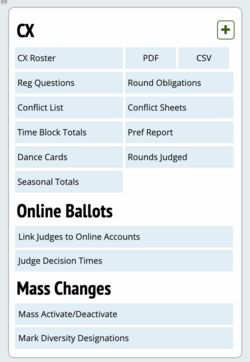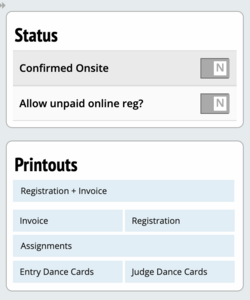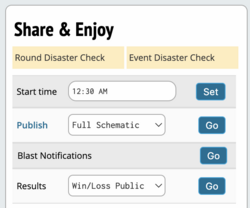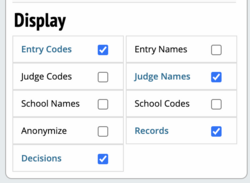Tournament Quick Start: Difference between revisions
| (26 intermediate revisions by the same user not shown) | |||
| Line 122: | Line 122: | ||
'''Messages''' - This lets you configure and send any information out to judges like live doc links, conflict policies, and school registration notices. | '''Messages''' - This lets you configure and send any information out to judges like live doc links, conflict policies, and school registration notices. | ||
For more information, see the section on | For more information, see the section on [[Settings/Judging]]. | ||
=== Events === | === Events === | ||
| Line 143: | Line 143: | ||
'''Updates''' - Completely optional, lets you have an email sent to someone (e.g. a tab person) when the first and last ballots are in for each round. | '''Updates''' - Completely optional, lets you have an email sent to someone (e.g. a tab person) when the first and last ballots are in for each round. | ||
To learn more, see the section on setting up [[Events]]. | To learn more, see the section on setting up [[Settings/Events]]. | ||
=== Schedule === | === Schedule === | ||
| Line 158: | Line 158: | ||
'''IMPORTANT TIP''' - For each round you schedule, you must select a "Type" and a "Tiebreaks" set. Otherwise, Tabroom won't know how to pair the round, and won't know what information to collect from judges on the ballot. This is probably the single most common mistake people make when setting up their tournament. | '''IMPORTANT TIP''' - For each round you schedule, you must select a "Type" and a "Tiebreaks" set. Otherwise, Tabroom won't know how to pair the round, and won't know what information to collect from judges on the ballot. This is probably the single most common mistake people make when setting up their tournament. | ||
For a more in-depth explanation of timeslots and scheduling rounds, see the section on [[Schedule]]. | For a more in-depth explanation of timeslots and scheduling rounds, see the section on [[Settings/Schedule]]. | ||
=== Sites & Rooms === | === Sites & Rooms === | ||
| Line 171: | Line 171: | ||
After all the rooms are entered, you'll usually create a "Room Pool" for each event, and potentially separate pools for certain elimination rounds. Creating a room pool is usually as simple as giving it a name and then clicking on the rooms to add to each pool. | After all the rooms are entered, you'll usually create a "Room Pool" for each event, and potentially separate pools for certain elimination rounds. Creating a room pool is usually as simple as giving it a name and then clicking on the rooms to add to each pool. | ||
For more info, see the section on [[Sites & Rooms]]. | For more info, see the section on [[Settings/Sites & Rooms]]. | ||
=== Money === | === Money === | ||
| Line 180: | Line 180: | ||
You'll want to make sure you have set the entry and judge fees/fines correctly - invoices will be automatically generated based on the numbers you enter. | You'll want to make sure you have set the entry and judge fees/fines correctly - invoices will be automatically generated based on the numbers you enter. | ||
For more information on the different types of fees/fines, see the section on [[Money]]. | For more information on the different types of fees/fines, see the section on [[Settings/Money]]. | ||
=== Website === | === Website === | ||
| Line 189: | Line 189: | ||
The Website section lets you configure what information/pages are visible on your tournaments site, or when accessing it through one of the tournament calendars. Note that your "Invitation" document is uploaded separately in '''Settings - Tournament.''' | The Website section lets you configure what information/pages are visible on your tournaments site, or when accessing it through one of the tournament calendars. Note that your "Invitation" document is uploaded separately in '''Settings - Tournament.''' | ||
Whether you include additional information or customize your tournaments website is optional. For more information, see the section on your [[Website]]. | Whether you include additional information or customize your tournaments website is optional. For more information, see the section on your [[Settings/Website]]. | ||
== Entries Tab == | == Entries Tab == | ||
| Line 273: | Line 273: | ||
There are two different methods of offering hired judging, both of which may be used alone or simultaneously. You can offer tournament-provided hired judging and then let people request hired rounds, and/or you can enable a "hiring exchange" where judges can offer hired rounds and schools can hire them without you needing to manually match them up. | There are two different methods of offering hired judging, both of which may be used alone or simultaneously. You can offer tournament-provided hired judging and then let people request hired rounds, and/or you can enable a "hiring exchange" where judges can offer hired rounds and schools can hire them without you needing to manually match them up. | ||
For more information on enabling hired judging, see the | For more information on enabling hired judging, see the section on [[Managing Entries]]. | ||
=== Invoices & Finances === | === Invoices & Finances === | ||
| Line 282: | Line 282: | ||
Note that if you have configured "concessions" such as parking passes during your tournament setup, there will also be an additional "Concessions" tab for each school where you can view and modify their concessions order and amount owed - but the total amount will also be reflected on the main invoice. | Note that if you have configured "concessions" such as parking passes during your tournament setup, there will also be an additional "Concessions" tab for each school where you can view and modify their concessions order and amount owed - but the total amount will also be reflected on the main invoice. | ||
To see information about money and payments in the aggregate rather than one school at a time, you can use the "Reports" menu option instead, and then the " | To see information about money and payments in the aggregate rather than one school at a time, you can use the "Reports" menu option instead, and then the "Finances/Concessions" section of the sidebar: | ||
[[File:register_reports_index-money.png|300px|center|border]] | [[File:register_reports_index-money.png|300px|center|border]] | ||
| Line 296: | Line 296: | ||
[[File:register_school_edit-status.png|250px|border]] | [[File:register_school_edit-status.png|250px|border]] | ||
If you are using online on-site registration, then each school will be able to log in on Tabroom and mark themselves as on-site - their status will then be updated on the school's page, so you can monitor who has arrived. | If you are using online on-site registration, then each school will be able to log in on Tabroom and mark themselves as on-site - their status will then be updated on the school's page, so you can monitor who has arrived. | ||
| Line 314: | Line 314: | ||
[[File:tabs_paneling.png|500px]] | [[File:tabs_paneling.png|500px]] | ||
The "Paneling" tab is where you pair IE prelims. Most of the time, you'll pair all the prelims for all events in advance. All you need to do is click the " | The "Paneling" tab is where you pair IE prelims. Most of the time, you'll pair all the prelims for all events in advance. All you need to do is click the "Mass Section All IE/Congress Prelims" button, and then select a section size for each event (the more sections, the smaller the average size). You can also choose to have it assign the rooms at the same time: | ||
[[File:panel_round_mass-create.png|600px|center|border]] | [[File:panel_round_mass-create.png|600px|center|border]] | ||
| Line 325: | Line 325: | ||
Rooms for IE events are usually assigned during the pairing step - but if you need to configure room pools or reassign rooms, you can do it with the Paneling - Rooms menu option. | Rooms for IE events are usually assigned during the pairing step - but if you need to configure room pools or reassign rooms, you can do it with the Paneling - Rooms menu option. | ||
Finally, you can also publish ballots and feedback for rounds in each event from the Paneling tab. To publish ballots, select the Paneling - Web Publish menu option. You may then choose to publish ballots per round per event or mass publish all ballots for events once the tournament has concluded. | |||
[[File:Paneling Web Publish Ballots.png|600px|center|border]] | |||
=== Schemats Tab (aka Pairing Debate) === | === Schemats Tab (aka Pairing Debate) === | ||
[[File:tabs_schemats.png|500px]] | [[File:tabs_schemats.png|500px]] | ||
Debate events are paired directly from the schematic, as are IE elims. First, select the event from the menu, then choose the appropriate tab for the round you want to pair. The pairing functions are on the sidebar under " | Debate events are paired directly from the schematic, as are IE elims. First, select the event from the menu, then choose the appropriate tab for the round you want to pair. The pairing functions are on the sidebar under "Change & Destroy" - if you've already created a pairing for that round, you might need to expand the box to see the options, so you don't accidentally overwrite a round. | ||
[[File:panel_schemat_show-change-debate.png|300px|center|border]] | [[File:panel_schemat_show-change-debate.png|300px|center|border]] | ||
To pair the round automatically, use the "Auto-pair | To pair the round automatically, use the "Auto-pair" link on the sidebar. The majority of the time, this is all you need to do to have a finished pairing based on the powermatching or preset rules you've set up in your tournament settings. | ||
If necessary, you can use the manual powermatcher instead by clicking the link on the sidebar. This will let you visually create a pairing by viewing the teams in bracket order, and manipulate the pairing however you like. | If necessary, you can use the manual powermatcher instead by clicking the link on the sidebar. This will let you visually create a pairing by viewing the teams in bracket order, and manipulate the pairing however you like. | ||
| Line 366: | Line 370: | ||
=== Publishing & Printing Rounds === | === Publishing & Printing Rounds === | ||
Once you have panels, judges, and rooms, you can publish the round on the web, text/email blast participants, and/or print out schematics and ballots. Most of this is done on the schematic in the "Share & Enjoy" and "Display | Once you have panels, judges, and rooms, you can publish the round on the web, text/email blast participants, and/or print out schematics and ballots. Most of this is done on the schematic in the "Share & Enjoy" and "Display" sections of the sidebar: | ||
[[File:panel_schemat_show-share.png|250px|border]] | [[File:panel_schemat_show-share.png|250px|border]] | ||
[[File:panel_schemat_show-display.png|250px|border]] | [[File:panel_schemat_show-display.png|250px|border]] | ||
For | For IEs, you can access additional postings and printouts from the Paneling - Reports menu option. | ||
== Tabbing Tab (aka Entering Ballots) == | == Tabbing Tab (aka Entering Ballots) == | ||
| Line 381: | Line 385: | ||
To enter a ballot, choose "Enter Ballots," then choose a judge group, time slot, and event on the sidebar. You will then be shown a list of ballots, sorted by judge code/name.. The "Entry" tab contains outstanding ballots - once they are entered, they will appear on the "Done" tab instead. If you have "double enter" set as your ballot entry method, then ballots which have only been entered once will be shown in yellow: | To enter a ballot, choose "Enter Ballots," then choose a judge group, time slot, and event on the sidebar. You will then be shown a list of ballots, sorted by judge code/name.. The "Entry" tab contains outstanding ballots - once they are entered, they will appear on the "Done" tab instead. If you have "double enter" set as your ballot entry method, then ballots which have only been entered once will be shown in yellow: | ||
[[File:tabbing_entry_index-entry.png| | [[File:tabbing_entry_index-entry.png|250px|center|border]] | ||
To enter a ballot, click on the judge code/name. You will then be shown the ballot entry screen: | To enter a ballot, click on the judge code/name. You will then be shown the ballot entry screen: | ||
| Line 387: | Line 391: | ||
[[File:tabbing_entry_index-debate.png|600px|center|border]] | [[File:tabbing_entry_index-debate.png|600px|center|border]] | ||
Read the "Hints & Shortcuts" section below the ballot you're entering for an explanation of the keyboard shortcuts - otherwise you might find yourself entering incorrect values. When giving a bye, you can leave the points blank to give average points - otherwise, any value you enter, including a zero, will be used instead. | Read the "Hints & Shortcuts" section below the ballot you're entering for an explanation of the keyboard shortcuts - otherwise you might find yourself entering incorrect values. When giving a bye, you can leave the points blank to give average points - otherwise, any value you enter, including a zero, will be used instead. | ||
| Line 397: | Line 399: | ||
=== Event Status === | === Event Status === | ||
The "Status" menu option gives you a convenient central place to view the status of each event, such as how many ballots are still out, whether a round is ready to pair, etc. | The "Status" menu option gives you a convenient central place to view the status of each event, such as how many ballots are still out, whether a round is ready to pair, etc. The 'Event Overview' tab will show you a box for each event, with how many rounds haven't started, how many ballots are still outstanding, and the status of ballot entry. | ||
[[File:tabbing_status_dashboard-tabs.png|700px]] | |||
[[File:tabbing_status_dashboard-tabs.png| | |||
The | The "Round Status" tab is a useful way to quickly mark which debates have started (or been marked as started by a judge, when using online ballots) - for example, someone from the tab room can walk down the hall and mark each debate started on their phone. | ||
== Results Tab == | == Results Tab == | ||
| Line 412: | Line 413: | ||
The "Reports" menu option is where you generate printouts for any kind of result set you need, including lists of entries and speaker awards for an awards ceremony. | The "Reports" menu option is where you generate printouts for any kind of result set you need, including lists of entries and speaker awards for an awards ceremony. | ||
The "Web Publish" menu option lets you flexibly choose which results to make available on Tabroom. To publish a results report, you first need to " | The "Web Publish" menu option lets you flexibly choose which results to make available on Tabroom. To publish a results report, you first need to use the "Result Sheets" in the sidebar: | ||
[[File:tabbing_publish_index-calculate.png|250px|center|border]] | [[File:tabbing_publish_index-calculate.png|250px|center|border]] | ||
Choose an event, the type of report, and whether to make it public, then click " | Choose an event, the type of report, and whether to make it public, then click "Generate." Once you have generated the report, it will appear in the list on the left. For each report, you can choose whether it should be published on the web or kept private. | ||
[[Category:Tabroom Manual|1c]] | [[Category:Tabroom Manual|1c]] | ||
Latest revision as of 19:40, 21 September 2024
This Tournament Quick Start guide is designed to give you a high-level overview of the steps involved in tabbing a tournament using Tabroom. It's written with a first-time tabber in mind, but may also be useful for experienced tabbers as a checklist reminder of what to do at each stage of running a tournament. Each section is deliberately brief - more information and extensive documentation on each feature can be found in the rest of the manual.
With the sheer number of options and settings available, tabbing a tournament can sometimes feel overwhelming. Fortunately, most of the options on Tabroom are only there if you need them - almost everything is set to a reasonable default, so if you're not sure what something does or whether you need it, it's usually safe to just leave it alone.
At its most basic, running a round successfully only requires three things - competitors, a judge, and a room. The process of running a tournament is mostly about providing those three things in a (hopefully, somewhat) timely fashion. Everything else is just details.
If you were to sum up the order of said details in the most general sense, it would look something like this:
1) Set up the tournament - define events, rules, schedules, rooms, etc.
2) Let people register so you have entries and judges
3) Pair/panel a round
4) Enter ballots or let judges do it themselves
5) Repeat #3 and #4 until the tournament is done
6) Publish the results
That's it! This guide and manual will walk you through each of the above steps.
Getting Started
If you want to follow along with this guide, you'll first need to Request A Tournament. You'll be given the option during setup of marking the tournament as a "Test Tournament" - this means the tournament won't be listed on the main calendar, and will give you some additional options to do things like create fake entries/judges and fake results, so you can walk through the entire process of running a tournament from start to finish.
Once you have a tournament linked to your account, the first step is to make it your active tournament by clicking on it in your sidebar:
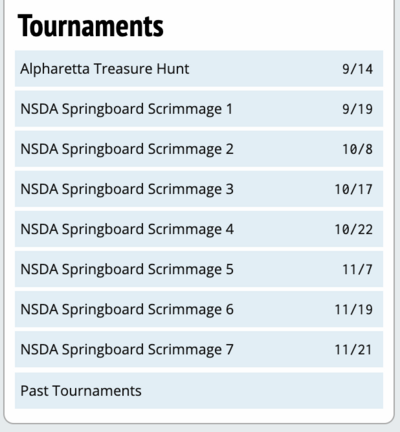
You'll notice the top row of tabs change - you're now in "Tournament Mode" rather than the general public website:
IMPORTANT TIP: Tabroom is designed to progress logically from left to right, and top to bottom. When in doubt, going on to the "next" menu option will usually put you in the right place.
Each of these tabs corresponds to one of the stages of running a tournament, from beginning to end:
Settings - Contains all the options for things that need to be set up before the tournament, such as events, registration, judge and tabulation rules, entering rooms, scheduling rounds, setting entry fees, etc.
Entries - Lets you view and manipulate entries for competitors and judges, along with some helpful features for manipulating your tournament data, importing/exporting your tournament from other tab programs, etc.
Paneling - Creates pairings and assigns judges for Individual Events. Is not really used for debate events (CX, LD, PF, etc.). The main exception is room pools, which are configured here for all events.
Schemats - Creates and manipulates schematics (a.k.a. pairings, postings) for debate events, including assigning judges and rooms, and lets you view or print them for all events.
Tabbing - For entering ballots and tabulating various results.
Results - For creating and publishing results after the tournament is over.
Settings Tab (aka Tournament Setup)
The Settings tab is where you configure your tournament, from general options to setting up judge categories, events, and the schedule.
The vast majority of problems people have when tabbing a tournament are the result of having failed to properly set something up in advance. To ensure your tournament runs as smoothly as possible, you'll want to check the settings described in this section thoroughly before starting to pair rounds.
In general, you should work your way through the menu options from top to bottom, and check each set of settings carefully. To successfully tab a tournament, you will need to progress through each of these setup steps - it's usually easiest to do them in the order presented here.
It's also a good idea to get these settings configured before registration for your tournament opens - otherwise you may end up with inaccurate registration data that needs to be fixed.
General Settings
The "Tournament" menu option contains a number of tabs with general settings for your tournament. Usually, you should scan through all the options on each tab and just set the ones that look applicable to your situation.
Name & Info - Most of this information will already be filled out from when you requested the tournament. If necessary, this is where you can add/remove your tournament from different circuits, and where you upload your tournament invitation document or congress bill packet.
Settings - This tab lets you mark a tournament as a "Test" tournament that won't be listed on the calendar, or a "Closed" tournament where you create all the entries/judges yourself instead of using Online Registration. You can also decide if you want to require adult contact information to register, which is a good idea at most high school tournaments.
Dates & Deadlines - Contains various deadlines, such as when registration opens and closes. These were set automatically when you requested the tournament, so unless you need to change them, the defaults are probably okay.
Access - If you need to give additional people administrative access to the tournament on Tabroom (e.g. tab staff), add them here.
Housing - Only needed if you plan to offer tournament-provided housing, which you probably aren't.
Messages - Lets you create messages shown to all registrants or placed on invoices. Totally optional.
Notes - This can be used to keep a scratchpad of ideas/problems during the tournament, so that if you run the same tournament the following year, you can look back on your notes and (hopefully) not repeat the same mistakes twice.
Payment - This tab lets you choose the number of NSDA Campus rooms you need for your tournament and to pay for those rooms and the use of Tabroom.com before your tournament begins.
For more in-depth explanation of each, see the section on General Settings.
Rules & Results
"Rules & Results" is where you set up Tiebreakers and Sweepstakes rules. Tiebreakers are rules for determining the seed order in each round (for powermatching prelims), or who breaks to the next round (for elims). This is where you configure things like "break ties on High/Low Points, then Total Points, then Opponent Wins."
Your tournament comes with some default Tiebreak sets, including separate sets for Debate, Speech, and Congress, for both prelims and elims. You can edit these or create your own - or if you're unsure what any of it means, you can just use the built-in tiebreakers, which are a very reasonable default.
If your tournament doesn't have sweepstakes, you can ignore that tab. Otherwise, you can set up the rules for determining sweepstakes points.
You may also choose to auto report TOC bids when you set the bid level for each event or auto report NDCA qualification for its season-long awards in the Points & Bids tab.
For more information on configuring Tiebreaks and Sweepstakes, see the longer section on Rules & Results.
Judge Categories
The "Judges" menu option is where you set up Judge Categories. A "Judge Category" is a collection of judges which can be used in one or more events or divisions. Every event must be in one and only one judge category. For example, you might have a category of judges that can judge either the novice or open divisions of policy, a second judge category exclusively for congress judges, and a third category of judges which could judge any other IE event.
It may seem odd to set up your judge categories before setting up your events - just remember that a single category of judges may be used across multiple events, but a single event will only ever pull from a single judge category. This means it makes more sense to assign events to judge categories than the other way around.
Note that a Judge CATEGORY is different than a Judge POOL - Judge Pools are used to draw from a specific subset of judges in the larger judge category - for example, only the judges that are still obligated for the semi-finals.
After creating or selecting a judge category from the sidebar, you'll see a list of tabs with the settings for that judge category:
Register - General settings for the judge category. The most important option to set is choosing a "burden method" to compute judge obligations. You should also make sure to set an abbreviation for each judge category. Most of the time, the rest of the default options are fine.
Hires - If you plan to offer hired judging at the tournament, or want to enable a "hiring exchange" where judges and schools can match up with each other, configure it here.
Tabbing - Contains options about how judges are placed, a few MPJ-related options, and lets you choose a method for ballot entry (i.e. whether you have to double-enter each ballot). The defaults on this tab are usually sufficient for most situations.
Ratings - This is where you configure mutually-preferred judging. For the most part, all you need to do is double check the date/time that prefs open and close, and then choose a "Pref Method," whether using Ordinals or Tiers.
MPJ Tiers - If you enabled a tier-based MPJ method on the Ratings tab, this tab will appear and let you configure them.
Time Shifts - If you have a number of judges likely to be unavailable for large blocks of the tournament (such as judges that only come on Saturday), you can configure time shifts here that allow registering schools to mark their judges as "unavailable" during certain times. If you just have a few judges that need to miss a round here or there, you probably don't need to use this - you can instead just add a time strike for that judge. Make sure you read the directions on this tab for how to name your time blocks, to help avoid confusion.
Pools - This lets you configure sub-pools of judges from the larger judge category, for example only judges still obligated in an elimination round. Using these is optional, but can make your life easier. You can also create pools as you go through the tournament, so leaving them alone during the initial configuration is fine.
Messages - This lets you configure and send any information out to judges like live doc links, conflict policies, and school registration notices.
For more information, see the section on Settings/Judging.
Events
This is where you configure which events/divisions you will offer at the tournament. Once you have created or selected an event on the sidebar, you will have a number of tabs with options for that event:
Main - General settings that you set when you created the event. Make sure you set a minimum and maximum number of competitors per entry (almost always both 1 for Speech, Congress, and LD, 2 for both PF and Policy, and 3 minimum and 5 maximum for WSD). You should also set the appropriate event "Type" so that Tabroom knows what types of options to show you for that event. If you have NSDA members attending your tournament, you'll also see an option to select an NSDA event type for each event. You must choose this event type for each event to enable NSDA auto-pointing.
Registration - The defaults on this tab are usually good for most situations. Primarily useful if you need to set a cap on the number of entries or use a waitlist.
Online - Lets you choose whether your event is being held online or in person. If your tournament is being held online, you can choose the type of NSDA Campus rooms you need for each event (ex: rooms to allow observers, no observers, etc.). This tab will also allow you to setup whether your speech events will occur asynchronously using uploaded video links and whether your tournament events will occur synchronously with pre-created room URLs.
Sectioning/Chambers/Pairing - This tab allows you to set specifics related to the pairing, judging, and web publishing in each event of your tournament.
Tabulation - The most commonly set item on this tab is to enable Online Ballots. Make sure you set a number for minimum and maximum speaker points - otherwise your online ballots will appear blank. You can also enable use of online coin flips in this tab. The default settings for powermatching, judges, and results should be fine for most situations - but if you need to change something like how presets are paired, this is where you do it.
Ballot & Rules - Lets you configure the appearance of the ballot for the event. The default is fine if you don't want to mess around with it.
Updates - Completely optional, lets you have an email sent to someone (e.g. a tab person) when the first and last ballots are in for each round.
To learn more, see the section on setting up Settings/Events.
Schedule
The Schedule tab tends to be one of the areas which confuses first-timers the most. You'll proceed in two parts - setting up timeslots, and then scheduling rounds from different events in those timeslots.
Tabroom divides up your schedule into "Timeslots" rather than Rounds. Each timeslot can then have one or more rounds (from one or more events) assigned to it. Different timeslots can also overlap, for example if you had different events running at different sites that started at different overlapping times. You can also have multiple timeslots with identical start/end times but different names for different events if it helps you keep things straight - like an 8-10 slot for Policy and an 8-10 slot for IE's. For an example, see the image below.
First, create your timeslots, which should largely mimic your tournament schedule. Then, click each event on the sidebar and schedule rounds in the appropriate timeslots:

This is also where you can select whether to double-flight rounds for a particular event.
IMPORTANT TIP - For each round you schedule, you must select a "Type" and a "Tiebreaks" set. Otherwise, Tabroom won't know how to pair the round, and won't know what information to collect from judges on the ballot. This is probably the single most common mistake people make when setting up their tournament.
For a more in-depth explanation of timeslots and scheduling rounds, see the section on Settings/Schedule.
Sites & Rooms
Sites & Rooms is where you enter your list of available rooms. You can then create "Room Pools" for each event, so that they stay in the same rooms.
On Tabroom, a "Site" is a grouping of all the rooms at one tournament location, such as a campus or hotel. Odds are, you'll only need one "site," even if you use multiple buildings. You only need to create multiple sites if your tournament is very large and spread over completely different locations (such as two separate high schools, or a campus and a hotel).
Once you have created a site, you can either enter the rooms manually or import them from a CSV file. If you use a CSV file, make sure to pay close attention to the instructions on how to format your file.
Optionally, you can assign a "Quality" rating to each room, where 1 is best and subsequent numbers are progressively worse - ties are fine, and the scale is open-ended. Tabroom will then attempt to assign the "best" rooms first.
After all the rooms are entered, you'll usually create a "Room Pool" for each event, and potentially separate pools for certain elimination rounds. Creating a room pool is usually as simple as giving it a name and then clicking on the rooms to add to each pool.
For more info, see the section on Settings/Sites & Rooms.
Money
The Money menu option lets you set up entry and judge fees, nuisance fines, as well as sell things like parking passes or meals (i.e. "concessions").
You are given the option of setting entry fees, judge fines, etc. in some of the other setup steps above. The Money section puts these all in one place for easy editing - if the same option exists in multiple places, it doesn't matter where you choose to set it.
You'll want to make sure you have set the entry and judge fees/fines correctly - invoices will be automatically generated based on the numbers you enter.
For more information on the different types of fees/fines, see the section on Settings/Money.
Website
Each tournament on tabroom comes with a public web address for accessing information about the tournament, schematics, results, etc. You chose the "web name" of your tournament when you requested it, and it will be something like:
http://mytournamentname.tabroom.com
The Website section lets you configure what information/pages are visible on your tournaments site, or when accessing it through one of the tournament calendars. Note that your "Invitation" document is uploaded separately in Settings - Tournament.
Whether you include additional information or customize your tournaments website is optional. For more information, see the section on your Settings/Website.
Entries Tab
The Entries tab is where you access and manipulate individual entry information, whether for a school, competitor, or judge. It's where you go when you need to add, drop, or change an entry, or view a school's invoice. Note that most information pages link to one another - so if you are viewing a judge, it's easy to get to their school's complete entry, or vice versa.
The functions available when viewing an entry/judge/school are also fairly self-explanatory. If you want to drop an entry, click the "Drop" button. If you want to change a name, click on it and edit it. If you want to change a judge's committed rounds, find their info page and change the number.
For a more detailed explanation of the options available for each entry, see the section on Managing Entries.
Creating Entries & Judges
If you're using online registration, it will open and close automatically based on the dates you set in the tournament settings. In this case, there's not much you need to do other than wait and let people register for the tournament.
If you need to manually create entries, you start with Entries - Data, and click "Add a New School." Fill out the required information, and then that school will be available for adding entries to.
Alternately, if you have complete registration data from another tab program (such as Joy of Tournaments), you can import the data into Tabroom by using the "Data" menu option.
Once you have schools, you can access them with the Entries - Schools menu. School's will be listed as "Not In" until they are marked as Registered. Once they are registered at the tournament, they will be in the "In" menu instead.
Each school will have a number of tabs for accessing their general info, entries, judges, and invoice. The Judges and Money tabs will appear in red if a school is under their judging obligations, or if they owe judge fees:
The "Entries" tab of a school's page will first show you the school's complete entry roster:
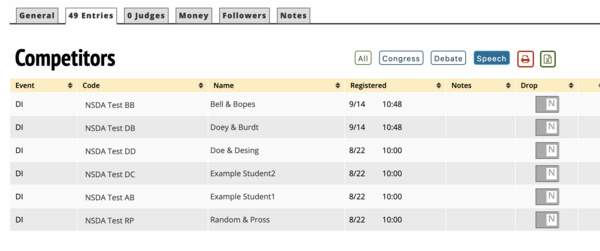
To access any individual entry, just click on their name or code. You can also Drop or Undrop an entry by toggling the button in the Drop column.
Once you have selected an event, you can manually add an entry, either from that school's roster, by entering their name, or just as a "TBA" slot:
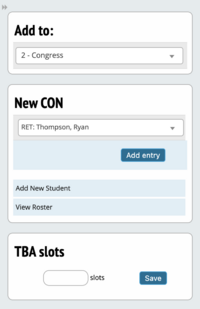
The "Judges" tab works the same way as "Entries" - you can view the school's current judge roster, edit an individual judge, or add a new judge to the school:

Modifying Entries & Judges
Once you have entries, either from online registration or entering them yourself, you can access their information either through the school's page, or directly with the "Entries" and "Judges" menu options. It's the same page any way you get there.
The "Events" and "Judges" menu options also include a variety of options on the sidebar for viewing information about the entire event/judge group:
Accessing an individual entry or judge's page will let you edit their information:

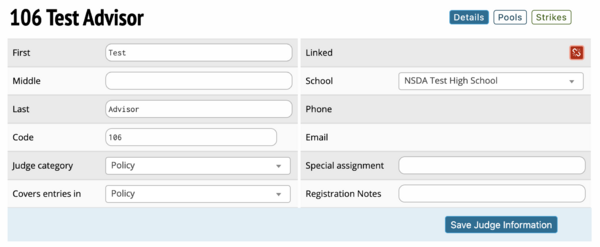
Use the links on the sidebar if you need to swap competitors, drop an entry/judge, view their prefs, etc.
Judge Availability
Often, you will need to mark a judge as "unavailable" during a certain time, or mark them as constrained against a particular entry. In Tabroom, any reason that a judge can't judge a particular debate is considered a "strike" - so you'll have different types of strikes such as a "time strike" or a "competitor strike."
To add or remove a "strike" for a judge, access their info page, click on the Strikes box in the right corner, and enter the "time strike" or "competitor strike." Once entered, strikes for the judge will appear on the right side of the page. To remove any strike, click the garbage can next to the time strike or competitor strike on the right side of the page.
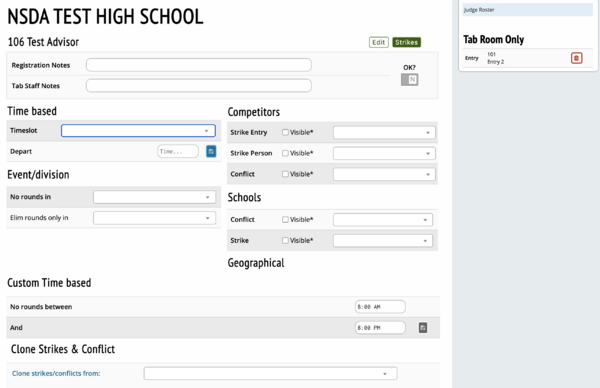
Important Note - When adding a time strike for a judge, be careful about the end time you select. If you have your schedule configured such that one round's end time is the same as the next round's start time, then a time strike placed on the boundary will prevent the judge being placed in either round, which is usually not the intended effect. So, for example, if you have Round 1 configured from 8-10 and Round 2 from 10-12, then giving a judge a time strike from 9-10 will prevent them judging either Round 1 or 2, because they are "unavailable" at exactly 10am. To prevent this, configure your scheduled time slots so that Round 1 ends at, for example, 9:30 instead of 10, and then give the judge a time strike from 9-9:55.
One helpful tip - make sure you scan the coaches notes column for each judge group before pairing your first round, as coaches frequently include availability information in the Notes field (e.g. "Not available round 1") instead of using time blocks correctly.
For more information, see the section on Managing Entries.
Linking Judge Accounts
If you are using online ballots for a judge group, you will see an additional section on the sidebar when viewing that judge group. This will give you options to manually link judge entries to their Tabroom accounts, or to approve requests from judges to do the linking (the link will appear in Red if there are active requests):
Waitlists
If you have enabled a waitlist for an event, you can manage it by selecting Entries -> Events, choosing an event, and then selecting "Waitlist" on the right. That will show you the entries on the waitlist, with the option of admitting them (including whether to automatically notify coaches):
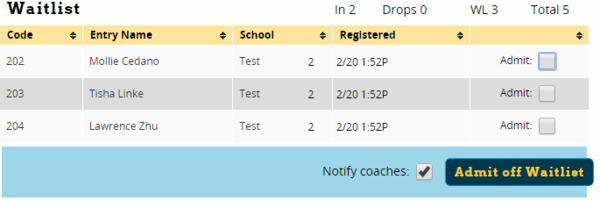
For more information, see the section on Managing The Waitlist.
Hired Judges
There are two different methods of offering hired judging, both of which may be used alone or simultaneously. You can offer tournament-provided hired judging and then let people request hired rounds, and/or you can enable a "hiring exchange" where judges can offer hired rounds and schools can hire them without you needing to manually match them up.
For more information on enabling hired judging, see the section on Managing Entries.
Invoices & Finances
Each school's invoice is computer automatically based on the entry and judge fees you set. To view a school's current invoice, use the "Money" tab of their school page. That's also where you can add or remove various fines, such as missed judge fees. You have the option of adding or removing fees from a school's invoice as you see fit.

Note that if you have configured "concessions" such as parking passes during your tournament setup, there will also be an additional "Concessions" tab for each school where you can view and modify their concessions order and amount owed - but the total amount will also be reflected on the main invoice.
To see information about money and payments in the aggregate rather than one school at a time, you can use the "Reports" menu option instead, and then the "Finances/Concessions" section of the sidebar:
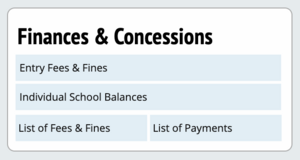
For more information, see the section on Managing Entries.
Registration
Tabroom's on-site registration functions are optional - they're just designed to make your life easier organizationally. Whether a school is marked as "Registered" or not has no effect on their entries or judges, they'll still be paired, etc. unless you have manually dropped them.
If you're having an in-person registration before the tournament, you can get all the printouts and invoices you need in the "Reports" section.
You can mark a school as registered by viewing their school info page, and then using the "Status" section of the sidebar:
If you are using online on-site registration, then each school will be able to log in on Tabroom and mark themselves as on-site - their status will then be updated on the school's page, so you can monitor who has arrived.
For more information, see the section on School Registration.
Pairing Rounds
Once you have a complete set of entries and judges, you can proceed to pairing rounds. This is done in the "Paneling" menu for IE prelims and the "Schemats" menu for debate events and all elims. If you are running a tournament without IE's, you'll really only use the Paneling menu for creating room/judge pools - everything else is done from the schematic.
Regardless of the method, pairing rounds is a three-stage process - Assigning Rounds, Assigning Judges, and Assigning Rooms. In practice, the automatic pairing functions will usually assign rooms at the same time as one of the other steps, so you'll really only need to press two buttons to get a complete pairing.
Before you proceed to pairing rounds, it's usually prudent to double-check your tournament settings - being sure you've configured everything right can save you a lot of headache down the line.
The below is abbreviated - for a more complete discussion of the options available, see the section on Pairing Rounds.
Paneling Tab (aka Pairing IE's)
The "Paneling" tab is where you pair IE prelims. Most of the time, you'll pair all the prelims for all events in advance. All you need to do is click the "Mass Section All IE/Congress Prelims" button, and then select a section size for each event (the more sections, the smaller the average size). You can also choose to have it assign the rooms at the same time:

Alternately, you can choose to panel a single event at a time using the links on the sidebar. You also have the option to manually create the panels yourself. In most situations, this is unnecessary and more prone to error than using the automatic paneler, but is available if you need it. To use, view the round you want to panel in the Schematics menu, then choose "Manually panel round" from the sidebar.
Once your rounds are created, you can assign IE judges with the Paneling - Judges menu option. Use the "Mass Assign" tab to add judges to all your prelims at once:
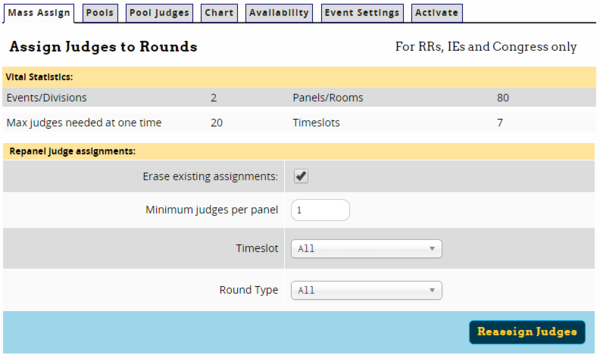
Rooms for IE events are usually assigned during the pairing step - but if you need to configure room pools or reassign rooms, you can do it with the Paneling - Rooms menu option.
Finally, you can also publish ballots and feedback for rounds in each event from the Paneling tab. To publish ballots, select the Paneling - Web Publish menu option. You may then choose to publish ballots per round per event or mass publish all ballots for events once the tournament has concluded.
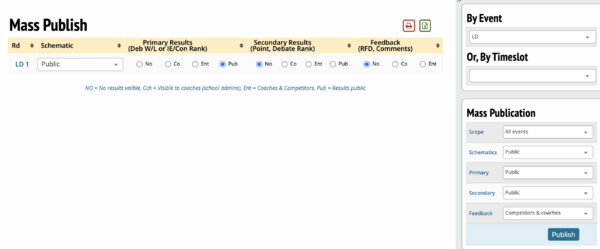
Schemats Tab (aka Pairing Debate)
Debate events are paired directly from the schematic, as are IE elims. First, select the event from the menu, then choose the appropriate tab for the round you want to pair. The pairing functions are on the sidebar under "Change & Destroy" - if you've already created a pairing for that round, you might need to expand the box to see the options, so you don't accidentally overwrite a round.
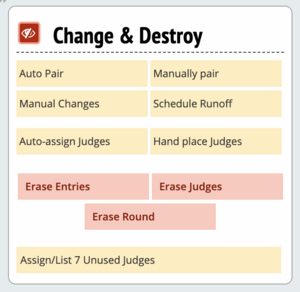
To pair the round automatically, use the "Auto-pair" link on the sidebar. The majority of the time, this is all you need to do to have a finished pairing based on the powermatching or preset rules you've set up in your tournament settings.
If necessary, you can use the manual powermatcher instead by clicking the link on the sidebar. This will let you visually create a pairing by viewing the teams in bracket order, and manipulate the pairing however you like.
Once you have a pairing, you can assign judges with the "Auto-assign judges" link. By default, this will try to assign rooms at the same time. If there are no error messages (such as insufficient judges), your pairing should be ready to go.
You also have the option of using the manual judge placer and dragging/dropping available judges into rounds. Most of the time, this is unnecessary - Tabroom usually does a pretty good job of testing out all the available options and coming up with the best fit for judges.
If you're using MPJ, you can see the prefs for each judge right on the schematic - if you then need to change a particular judge, you can click on their name and use the drop-down menus to see other available options.
Most of the time, rooms will be auto-assigned with the judges - but if necessary, you can assign rooms separately, either automatically or by hand.
Pairing Elims
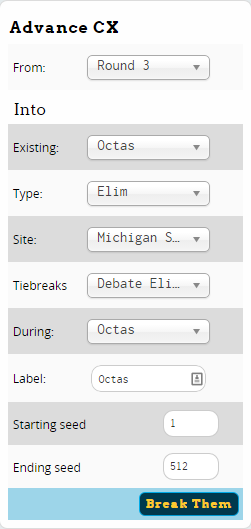
The process of pairing elims is similar for both debate and IE's, and is done directly from the schematic. First, access the event/round you want to pair, and then click the "Round Settings" link on the sidebar. This will let you set the number of judges on each panel, as well as make sure your elim settings are correct. Then, click "Auto-Pair break round."
You'll be shown a list of seeds in order, to help you figure out where the break should be. Then, select which round to break from (the last prelim or previous elim), verify the time blocks and tiebreak sets are set correctly, choose the starting/ending seed to break, and click "Break Them:"
Once you have rounds/panels, you can assign judges and rooms the same way you would for prelims - either using the Paneling -> Judges menu for IE's (make sure to select the correct time block and round), or directly from the schematic.
Manipulating Pairings
The process for manually making changes to a completed pairing is similar for both speech and debate events. Most things you would need to do can be accomplished by clicking on the entry/judge/room you need to change, and then following the on-screen instructions.
For example, to move an entry, you click on their name/code on the schematic, and you will be shown a clickable version of the pairing where you can click where you want to place them.
To replace a judge, click on their name/code on the schematic. This will show you the current judge, as well as dropdown menus for selecting from either judges who are currently available, or judges who are currently judging (you would then need to find a new judge for that round instead). Both menus will only show you "clean" judges with no conflicts, strikes, etc. Once you have added the new judge, remember to remove the old judge from the panel by clicking "Remove" or "RM & Fine" (if you have missed judging fees configured):

To change a room, click on the room name from the schematic. Then, use the dropdown menu labeled "Room" to switch the room. This menu will only show you "available" rooms that are in the appropriate pool and not scheduled for another round.
Publishing & Printing Rounds
Once you have panels, judges, and rooms, you can publish the round on the web, text/email blast participants, and/or print out schematics and ballots. Most of this is done on the schematic in the "Share & Enjoy" and "Display" sections of the sidebar:
For IEs, you can access additional postings and printouts from the Paneling - Reports menu option.
Tabbing Tab (aka Entering Ballots)
The "Tabbing" tab is where you manually enter ballots and monitor the status of each event. If you're using online ballots, the ballots are entered by the judges - but you can still use the Tabbing menu to monitor round starts, outstanding ballots, etc.
Entering Ballots
To enter a ballot, choose "Enter Ballots," then choose a judge group, time slot, and event on the sidebar. You will then be shown a list of ballots, sorted by judge code/name.. The "Entry" tab contains outstanding ballots - once they are entered, they will appear on the "Done" tab instead. If you have "double enter" set as your ballot entry method, then ballots which have only been entered once will be shown in yellow:

To enter a ballot, click on the judge code/name. You will then be shown the ballot entry screen:
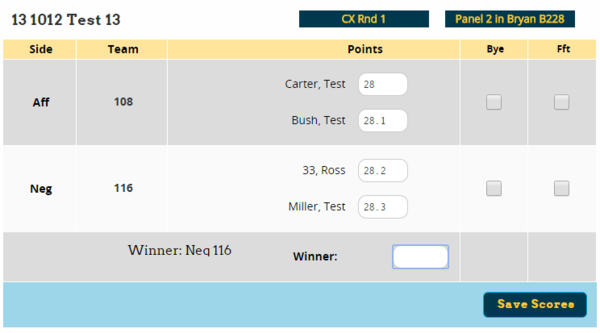
Read the "Hints & Shortcuts" section below the ballot you're entering for an explanation of the keyboard shortcuts - otherwise you might find yourself entering incorrect values. When giving a bye, you can leave the points blank to give average points - otherwise, any value you enter, including a zero, will be used instead.
Once you're done entering all the ballots for a round (usually, double-entering), you can proceed to pairing the next debate.
For a more in-depth discussion of how to enter ballots, see the section on Tabbing.
Event Status
The "Status" menu option gives you a convenient central place to view the status of each event, such as how many ballots are still out, whether a round is ready to pair, etc. The 'Event Overview' tab will show you a box for each event, with how many rounds haven't started, how many ballots are still outstanding, and the status of ballot entry.

The "Round Status" tab is a useful way to quickly mark which debates have started (or been marked as started by a judge, when using online ballots) - for example, someone from the tab room can walk down the hall and mark each debate started on their phone.
Results Tab
The "Results" menu is where you generate final results packets, ensure tournament results are published to the web, and see up-to-date seed ordering as the tournament progresses. Note that in addition to the Results menu, you usually choose whether to publish the results of individual rounds directly on the schematic in the "Share & Enjoy" section. of the sidebar.
For a rank-ordered list of entries in an event as of any round, use the "Event Display" menu option, then choose an event and round from the dropdown menus.
The "Reports" menu option is where you generate printouts for any kind of result set you need, including lists of entries and speaker awards for an awards ceremony.
The "Web Publish" menu option lets you flexibly choose which results to make available on Tabroom. To publish a results report, you first need to use the "Result Sheets" in the sidebar:
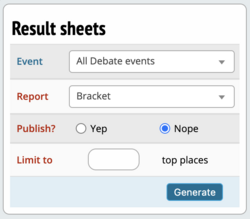
Choose an event, the type of report, and whether to make it public, then click "Generate." Once you have generated the report, it will appear in the list on the left. For each report, you can choose whether it should be published on the web or kept private.

